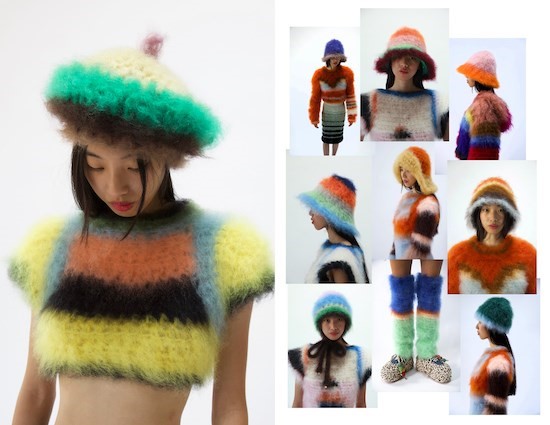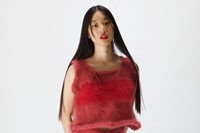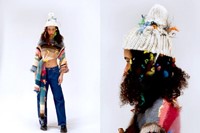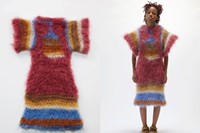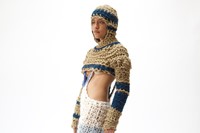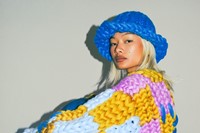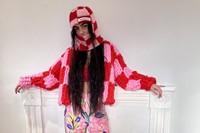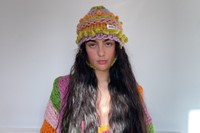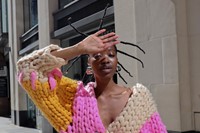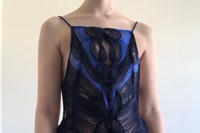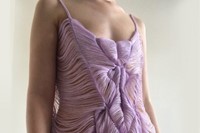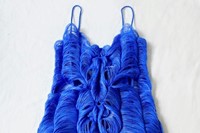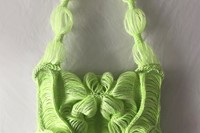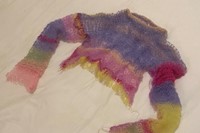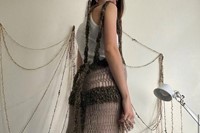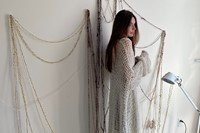A new guard of knitwear designers including Nong Rak, Vaisseau, Hope Macaulay and Emma Gudmundson talk us through their innovative, sustainable design practices
“A thing of beauty is a joy forever,” wrote the poet John Keats; a sentiment that chimes with the current mood in fashion. “More and more customers are looking for custom or one of a kind when it comes to a meaningful, sentimental wardrobe,” say the Thai-American duo behind knitwear label Nong Rak, Home Phuangfueang and Cherry W Rain-Phuangfueang. Rachel Holloway, the Canadian designer behind knitwear label Vaisseau says, “I think a large part of sustainability is caring for the things we own, owning less, and appreciating the manual hours put into creating them.” Today, there’s real momentum behind the idea that purchases should be considered and cherished for the long term, and that the era of consumption for the sake of it is over.
Nong Rak, which translates as ‘young love’ in Thai – Home’s country of origin, and the place where the pair (both romantic and business partners) met and married – is nothing if not unique. Described as “super organic wearable fibre art”, their ethereally fuzzy brushed mohair pieces have attracted a sizable following. The couple were floored by the “sudden, unexpected positive response” to their e-commerce collections, since they only started knitting in 2021. Each drop has sold out rapidly, “which is a double edge, since we’re excited but frustrated being unable to meet demand. Telling people that want to support us that we don’t have anything to offer feels sad, honestly”, they tell AnOther.
The pair spend a lot of time talking about and sourcing materials, buying vintage deadstock and second-hand yarns when available. Their multi-coloured garments facilitate using small quantities of different colours, plus working with “hand-spun and minimally processed artisan yarns which are sourced from a number of small, cruelty-free fibre farms and artisan spinners.” They produce the pieces using freeform crochet without a pattern, or knit directly on a hand-powered domestic machine.
Holloway, the knitwear artist behind Vaisseau, (the name is inspired by the word ‘vessel’ in French, and the phrase “the body is a vessel for one’s consciousness”) described “falling in love with how natural fibres and materials bring out the diversity of the textile medium.” After learning to knit and how to combine knitting with crochet, Holloway began to incorporate unusual techniques and fine, lace-weight yarns with bulky wools such as bouclé”, citing her most commonly used materials as mohair, alpaca, cotton, and wool.
Well aware of the problem of overconsumption and waste in the fashion industry, Holloway declines to participate in it, even as Vaisseau grows. Sustainability to her means “a made-to-order model (for stockists that include Effe and APOC), not over-purchasing material, sourcing secondhand or vintage yarns, avoiding plastics, and creating pieces out of scraps that wouldn’t be enough to make one cohesive piece.” Hers is a beneficial process, since “pieces are unique from one another; a blessing of sustainable creating.”
Hope Macaulay is also focussed on the materials used to create her signature colossal knit sweaters, cardigans and accessories. Using 100 per cent merino wool and 100 per cent biodegradable nylon knitted by hand (without needles!), Macaulay took three years of “trial and error” to develop her technique, but now has a booming made-to-order business from her own website and social channels, having become a favourite of every Gen-Z influencer around. “Made to order is great as a small business,” says the Northern Irish creative director. “You’re not using up valuable resources creating pieces that might not sell. For the customer, it makes custom orders possible.”
Macaulay’s biodegradable nylon “has been designed to be kinder to the planet and vegan friendly.” Using first-of-its-kind technology, it biodegrades in around five years when disposed of in landfills, compared to more than 50 years for synthetics in general. “Usually, the chemical structure of synthetic fibres does not allow for bacterial penetration, which makes the degradation process more complex and slower,” she explains. What makes this type of nylon different is that “it’s produced using enhanced polyamide, which – under landfill conditions – facilitates access and digestion of waste material by bacteria, thus accelerating the biodegradation process.” This process only functions “under landfill conditions, where there is no oxygen and anaerobic decomposition bacteria are found.” It won’t decompose after standard use, and has an equivalent lifecycle to traditional polyamide. Macaulay adds, “the yarn has also been manufactured by recycling processed water and is super soft to touch.”
Swedish designer Emma Gudmundson describes her aesthetic as “organic futurism” and uses techniques like flat knit, floats and hook-up stitches. “The hook-up stitches give the fabric its structure and surface patterns,” she says, appearing like 3D textures spun by teams of ambitious spiders. Gudmundson uses ecological cotton she buys locally, as well as different types of lurex and occasionally nylon monofilament. She adds that she’d love to try monofilament yarn made of fungus that she’s read about – if and when it becomes available.
Craig Lawrence, BA Fashion Knit pathway leader at Central Saint Martins, explains how knitwear lends itself to sustainable practices.“ Knitwear is less wasteful as knitted garments are fully fashioned, meaning that each knitted panel is shaped to follow the pattern piece then linked together. Seamless knitted technology, for hosiery and sportswear garments, means knitting in tubular shapes to create seamless garments,” which are “zero waste and can be more durable. As there are no seams, the garments have fewer weak spots.” Students of knitwear, he adds, “are inherently aware of the amount of yarn they would need.” Although, due to “supply chain and manufacturing, there will always be waste no matter what the process.”
Lawrence argues that disposable fashion culture has devalued craftsmanship; that garments should be valued related to the skills used to make them, which are currently “under-appreciated, which makes it easier for the consumer to discard things as there is no emotional attachment”. He praises designer Matty Bovan for producing his popular patchwork creations in-house, rather than contracting out to suppliers.
None of the knitters featured in this piece want to scale and grow their business in a way that would compromise their hand-made techniques and sustainable principles. Gudmundson is currently stocked at Browns Fashion and also works with Lunch Concept, with other stockists reaching out, which she is “stoked about”. She juggles work with another design role and is currently undecided about whether to go full-time. “It would be a dream come true to be able to support myself from my designs,” she says.
Meanwhile, the Phuangfueangs are scrambling to recruit; “two local crocheters just started and increased our production, but larger pieces are more complicated as they’re made experimentally without patterns.” The duo question whether scaling up would lose the magic of their pieces; they ask, “if our designs were produced in a run of 100, would people still be as drawn to them?” They’re also conscious of operating in the most environmentally conscious way, remembering that “fashion is a luxury that doesn’t really align with sustainability, and we’ll inevitably have a footprint that we’re going to have to offset.”
Valuing the expertise of makers – and controlling your own production while operating in a localised way – sounds like the perfect manifesto.
